Toyota RAV4: Do-it-yourself maintenance
Do-it-yourself service precautions
If you perform maintenance yourself, be sure to follow the correct procedures as given in these sections.
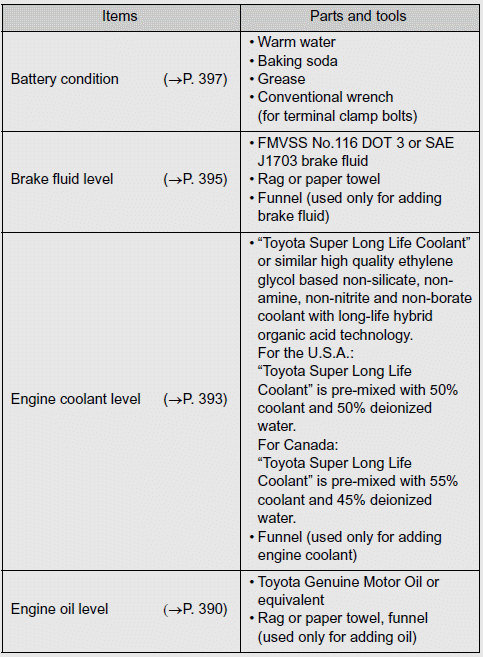
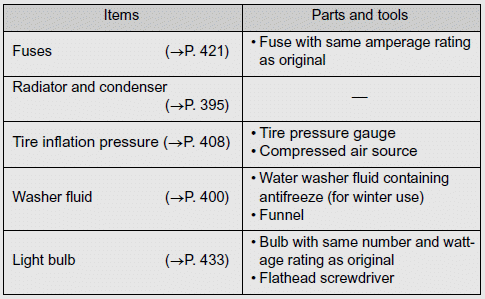
CAUTION
The engine compartment contains many mechanisms and fluids that may
move suddenly, become hot, or become electrically energized. To avoid death
or serious injury, observe the following precautions.
■When working on the engine compartment
●Keep hands, clothing, and tools away from the moving fans and engine
drive belt.
●Be careful not to touch the engine, radiator, exhaust manifold, etc. right
after driving as they may be hot. Oil and other fluids may also be hot.
●Do not leave anything that may burn easily, such as paper or rags, in the
engine compartment.
●Do not smoke, cause sparks or expose an open flame to fuel or the battery.
Fuel and battery fumes are flammable.
●Be extremely cautious when working on the battery. It contains poisonous
and corrosive sulfuric acid.
●Take care because brake fluid can harm your hands or eyes and damage
painted surfaces.
If fluid gets on your hands or in your eyes, flush the affected area with
clean water immediately.
If you still experience discomfort, see a doctor.
■When working near the electric cooling fans or radiator grille
Vehicles without smart key system: Be sure the engine switch is OFF. With
the engine switch in the “ON” position, the electric cooling fans may
automatically
start to run if the air conditioning is on and/or the coolant temperature
is high.
Vehicles with smart key system: Be sure the “ENGINE START STOP” switch
is OFF. With the “ENGINE START STOP” switch in IGNITION ON mode, the
electric cooling fans may automatically start to run if the air conditioning is
on
and/or the coolant temperature is high.
■Safety glasses
Wear safety glasses to prevent flying or falling material, fluid spray, etc.
from
getting in the eyes.
NOTICE
■If you remove the air cleaner filter
Driving with the air cleaner removed may cause excessive engine wear due
to dirt in the air. Also a backfire could cause a fire in the engine
compartment.
Hood
Release the lock from the inside of the vehicle to open the hood.

Pull the hood release lever. The hood will pop up slightly.

Lift the auxiliary catch lever and lift the hood.
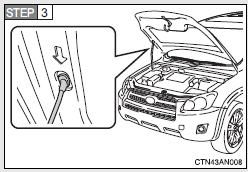
Hold the hood open by inserting the supporting rod into the slot.
CAUTION
■Pre-driving check
Check that the hood is fully closed and locked.
If the hood is not locked properly, it may open while the vehicle is in motion
and cause an accident, which may result in death or serious injury.
■After installing the support rod into the slot
Make sure the rod supports the hood securely from falling down on to your
head or body.
NOTICE
■When closing the hood
Be sure to return the support rod to its clip before closing the hood. Closing
the hood with the support rod up could cause the hood to bend.
Positioning a floor jack
When raising your vehicle with a floor jack, position the jack correctly. Improper placement may damage your vehicle or cause injury.
■ Front
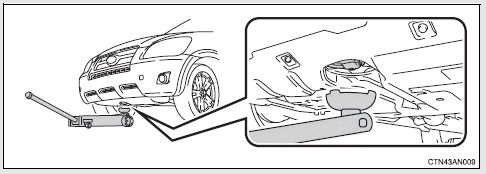
■ Rear

CAUTION
■When raising your vehicle
Make sure to observe the following to reduce the possibility of death or serious
injury.
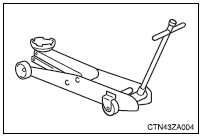
●Lift up the vehicle using a floor jack
such as the one shown in the illustration.
●When using a floor jack, follow the instructions of the manual provided with
the jack.
●Do not use the jack that was supplied with your vehicle.
●Do not put any part of your body or get underneath the vehicle supported
only by the floor jack.
●Always use floor jack and/or automotive jack stands on a solid, flat, level
surface.
●Do not start the engine while the vehicle is supported by the floor jack.
●Stop the vehicle on level firm ground, firmly set the parking brake and shift
the shift lever in P.
●Make sure to set the floor jack properly at the jack point.
Raising the vehicle with an improperly positioned floor jack will damage
the vehicle and may cause the vehicle to fall off the floor jack.
●Do not raise the vehicle while someone is in the vehicle.
●When raising the vehicle, do not place any objects on top of or underneath
the floor jack.
Engine compartment
2.5 L 4-cylinder (2AR-FE) engine
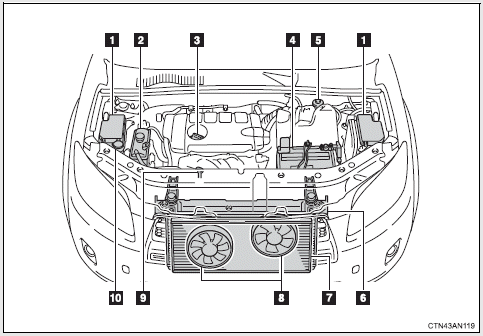
1 Fuse boxes
2 Engine coolant reservoir
3 Engine oil filler cap
4 Battery
5 Brake fluid reservoir
6 Radiator
7 Condenser
8 Electric cooling fans
9 Engine oil level dipstick
10 Washer fluid tank
3.5 L V6 (2GR-FE) engine
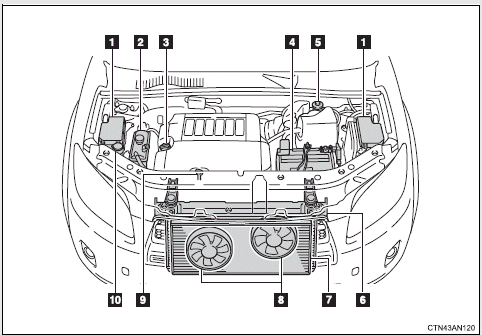
1 Fuse boxes
2 Engine coolant reservoir
3 Engine oil filler cap
4 Battery
5 Brake fluid reservoir
6 Radiator
7 Condenser
8 Electric cooling fans
9 Engine oil level dipstick
10 Washer fluid tank
Engine compartment cover
■ Removing the engine compartment cover
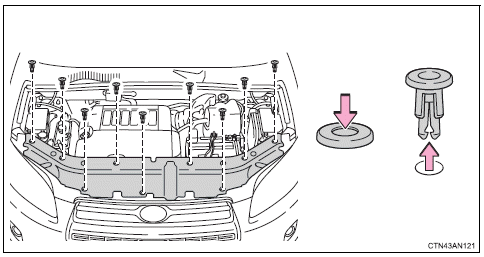
■ Installing the clips
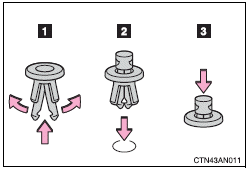
NOTICE
■After installing an engine compartment cover
Make sure that the cover is securely installed in its original position.
Engine oil
With the engine at operating temperature and turned off, check the oil level on the dipstick.
■ Checking the engine oil
1 Park the vehicle on level ground. After warming up the engine and turning it off, wait more than 5 minutes for the oil to drain back into the bottom of the engine.
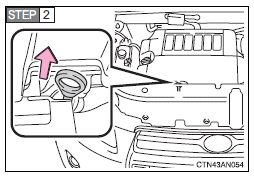
Hold a rag under the end and pull the dipstick out.
3 Wipe the dipstick clean.
4 Reinsert the dipstick fully.
5 Holding a rag under the end, pull the dipstick out and check
the oil level.
6 Wipe the dipstick and reinsert it fully.
2.5 L 4-cylinder (2AR-FE) engine
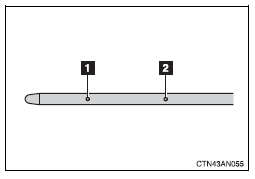
1 Low
2 Full
3.5 L V6 (2GR-FE) engine
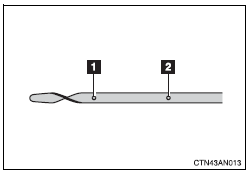
1 Low
2 Full
■ Adding engine oil
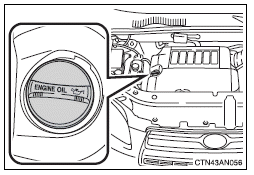
If the oil level is below or near the low level mark, add engine oil of the same type as already in the engine.
Make sure to check the oil type and prepare the items needed before adding oil.

1 Remove the oil filler cap by turning it counterclockwise.
2 Add engine oil slowly, checking the dipstick.
3 Install the oil filler cap by turning it clockwise.
■Engine oil consumption
A certain amount of engine oil will be consumed while driving. In the following situations, oil consumption may increase, and engine oil may need to be refilled in between oil maintenance intervals.
●When the engine is new, for example directly after purchasing the vehicle
or after replacing the engine
●If low quality oil or oil of an inappropriate viscosity is used
●When driving at high engine speeds or with a heavy load, when towing,
or when driving while accelerating or decelerating frequently
●When leaving the engine idling for a long time, or when driving frequently
through heavy traffic
CAUTION
■Used engine oil
●Used engine oil contains potentially harmful contaminants which may
cause skin disorders such as inflammation or skin cancer, so care should
be taken to avoid prolonged and repeated contact. To remove used engine
oil from your skin, wash thoroughly with soap and water.
●Dispose of used oil and filters only in a safe and acceptable manner. Do
not dispose of used oil and filters in household trash, in sewers or onto the
ground. Call your Toyota dealer, service station or auto parts store for
information concerning recycling or disposal.
●Do not leave used engine oil within the reach of children.
NOTICE
■To prevent serious engine damage
Check the oil level on a regular basis.
■When replacing the engine oil
●Be careful not to spill engine oil on the vehicle components.
●Avoid overfilling, as the engine could be damaged.
●Check the oil level on the dipstick every time you refill the vehicle.
●Be sure the engine oil filler cap is properly tightened.
Engine coolant
The coolant level is satisfactory if it is between the “FULL” and “LOW” lines on the reservoir when the engine is cold.
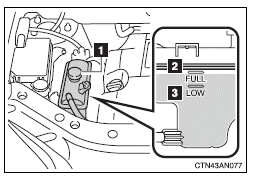
1 Reservoir cap
2 “FULL”
3 “LOW”
If the level is on or below the “LOW” line, add coolant up to the “FULL” line.
■If the coolant level drops within a short time after replenishing
Visually check the radiator, hoses, engine coolant reservoir cap, drain cock and water pump. If you cannot find a leak, have your Toyota dealer test the cap and check for leaks in the cooling system.
■Coolant selection
Only use “Toyota Super Long Life Coolant” or similar high quality ethylene
glycol based non-silicate, non-amine, non-nitrite, and non-borate coolant
with long-life hybrid organic acid technology.
U.S.A.: “Toyota Super Long Life Coolant” is a mixture of 50% coolant
and 50% deionized water. (Enabled: -31°F [-35°C])
Canada: “Toyota Super Long Life Coolant” is a mixture of 55% coolant
and 45% deionized water. (Enabled: -44°F [-42°C])
For more details about engine coolant, contact your Toyota dealer.
CAUTION
■When the engine is hot
Do not remove the coolant reservoir cap.
The cooling system may be under pressure and may spray hot coolant if the
cap is removed, causing serious injuries, such as burns.
NOTICE
■When adding engine coolant
Coolant is neither plain water nor straight antifreeze. The correct mixture of
water and antifreeze must be used to provide proper lubrication, corrosion
protection and cooling. Be sure to read the antifreeze or coolant label.
■If you spill coolant
Be sure to wash it off with water to prevent damage to parts or paint.
Radiator and condenser
Check the radiator and condenser, and clear any foreign objects. If either of the above parts are extremely dirty or you are not sure of their condition, have your vehicle checked by your Toyota dealer.
CAUTION
■When the engine is hot
Do not touch the radiator or condenser as they may be hot and cause serious
injuries, such as burns.
Brake fluid
■ Checking fluid level
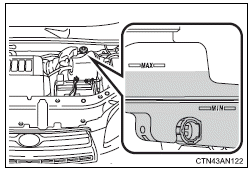
The brake fluid level should be between the “MAX” and “MIN” lines on the tank.
Make sure to check the fluid type and prepare the necessary items.
■ Adding fluid

■Brake fluid can absorb moisture from the air
Excess moisture in the fluid can cause a dangerous loss of braking efficiency. Use only newly opened brake fluid.
CAUTION
■When filling the reservoir
Take care because brake fluid can harm your hands or eyes and damage
painted surfaces.
If fluid gets on your hands or in your eyes, flush the affected area with clean
water immediately.
If you still experience discomfort, see a doctor.
NOTICE
■If the fluid level is low or high
It is normal for the brake fluid level to go down slightly as the brake pads
wear or when the fluid level in the accumulator is high.
If the reservoir needs frequent refilling, it may indicate a serious problem.
Battery
■ Battery exterior
Make sure that the battery terminals are not corroded and that there are no loose connections, cracks, or loose clamps.
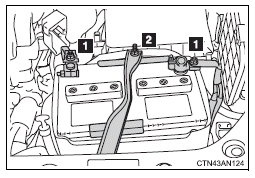
1 Terminals
2 Hold-down clamp
■Before recharging
When recharging, the battery produces hydrogen gas which is flammable and explosive. Therefore, before recharging:
●If recharging with the battery installed on the vehicle, be sure to
disconnect
the ground cable.
●Make sure the power switch on the charger is off when connecting and
disconnecting the charger cables to the battery.
■After recharging/reconnecting the battery (vehicles with smart key system)
In some cases, the engine may not start. Follow the procedure below to initialize the system.
1 Shift the shift lever to P, and turn the “ENGINE START STOP”
switch OFF.
2 Open and close any of the doors.
3 Start the engine. (If the engine does not start first time, repeat the
procedure.)
CAUTION
■Chemicals in the battery
A battery contains poisonous and corrosive sulfuric acid and may produce
hydrogen gas which is flammable and explosive. To reduce the risk of death
or serious injury, take the following precautions while working on or near the
battery:
●Do not cause sparks by touching the battery terminals with tools.
●Do not smoke or light a match near the battery.
●Avoid contact with eyes, skin and clothes.
●Never inhale or swallow electrolyte.
●Wear protective safety glasses when working near the battery.
●Keep children away from the battery.
■Where to safely charge the battery
Always charge the battery in an open area. Do not charge the battery in a
garage or closed room where there is not sufficient ventilation.
■How to recharge the battery
Only perform a slow charge (5 A or less). The battery may explode if
charged at a quicker rate.
CAUTION
■Emergency measures regarding electrolyte
●If electrolyte gets in your eyes
Flush your eyes with clean water for at least 15 minutes and get immediate
medical attention. If possible, continue to apply water with a sponge or
cloth while traveling to the nearest medical facility.
●If electrolyte gets on your skin
Wash the affected area thoroughly. If you feel pain or burning, get medical
attention immediately.
●If electrolyte gets on your clothes
It can soak through clothing on to your skin. Immediately take off the clothing
and follow the procedure above if necessary.
●If you accidentally swallow electrolyte
Drink a large quantity of water or milk. Get emergency medical attention
immediately.
NOTICE
■When recharging the battery
Never recharge the battery while the engine is running. Also, be sure all
accessories are turned off.
Washer fluid
For vehicles sold in U.S.A.
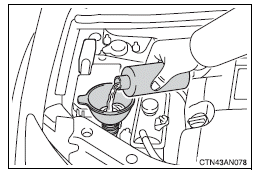
Add washer fluid in the following situations.
● Any washer does not work.
● The low washer fluid warning
light comes on.
For vehicles sold in Canada
If any washer does not work or the low windshield washer fluid warning light comes on, the washer tank may be empty. Add washer fluid.
CAUTION
■When filling the washer fluid
Do not refill the washer fluid when the engine is hot or running, as the
washer fluid contains alcohol and may catch fire if spilled on the engine etc.
NOTICE
■Do not use any fluid other than washer fluid
Do not use soapy water or engine antifreeze instead of washer fluid.
Doing so may cause streaking on the vehicle’s painted surfaces.
■Diluting washer fluid
Dilute washer fluid with water as necessary.
Refer to the freezing temperatures listed on the label of the washer fluid
bottle.
Tires
Replace or rotate tires in accordance with maintenance schedules and treadwear.
■ Checking tires
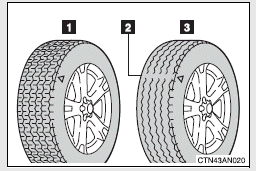
1 New tread
2 Treadwear indicator
3 Worn tread
The location of treadwear
indicators is shown by the
“TWI” or “ ” marks, etc.,
molded on the sidewall of
each tire.
Check spare tire condition
and inflation pressure if not
rotated.
” marks, etc.,
molded on the sidewall of
each tire.
Check spare tire condition
and inflation pressure if not
rotated.
■ Tire rotation
Vehicles with a spare tire of the same wheel type as the installed tires
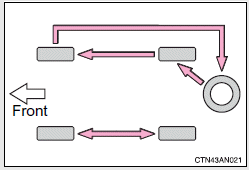
Rotate the tires in the order shown. To equalize tire wear and extend tire life, Toyota recommends that tire rotation is carried out at the same interval as tire inspection.
Except vehicles with a spare tire of the same wheel type as the installed tires
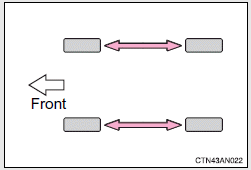
Rotate the tires in the order shown. To equalize tire wear and extend tire life, Toyota recommends that tire rotation is carried out at the same interval as tire inspection.
■ The tire pressure warning system (if equipped)
Your Toyota is equipped with a tire pressure warning system that uses tire pressure warning valves and transmitters to detect low tire inflation pressure before serious problems arise.
Installing tire pressure warning valves and transmitters (vehicleswith a tire pressure warning system)
When replacing tires or wheels, tire pressure warning valves and transmitters must also be installed. When new tire pressure warning valves and transmitters are installed, new tire pressure warning valve and transmitter ID codes must be registered in the tire pressure warning computer and the tire pressure warning system must be initialized. Have tire pressure warning valve and transmitter ID codes registered by your Toyota dealer.
Registering ID codes (vehicles with a tire pressure warningsystem)
The tire pressure warning valve and transmitter is equipped with a unique ID code. When replacing a tire pressure warning valve and transmitter, it is necessary to register the ID code of tire pressure warning valve and transmitter. Have the ID code registered by your Toyota dealer.
■When to replace your vehicle's tires
Tires should be replaced if:
●You have tire damage such as cuts, splits, cracks deep enough to
expose the fabric, or bulges indicating internal damage.
●A tire goes flat repeatedly or cannot be properly repaired due to the
size or location of a cut or other damage.
If you are not sure, consult with your Toyota dealer.
■Replacing tires and wheels (vehicles with a tire pressure warning system)
If the ID code of the tire pressure warning valve and transmitter is not registered, the tire pressure warning system will not work properly. After driving for about 20 minutes, the tire pressure warning light comes on after blinking for 1 minute to indicate a system malfunction.
■Tire life
Any tire over 6 years old must be checked by a qualified technician even if they have seldom or never been used or damage is not obvious.
■If the tread wears down below 0.16 in. (4 mm) on snow tires
The effectiveness of snow tires is lost.
■Maximum load of tire
Check that the number given by dividing the maximum load by 1.10 of the replacement tire is greater than 1/2 of the Gross Axle Weight Ratings (GAWR) of either the front axle or the rear axle, whichever is greater.
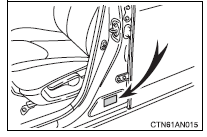
For the GAWR, see the Certification Label. For the maximum load of the tire, see the load limit at maximum cold tire inflation pressure mentioned on the sidewall of the tire.
■Tire types
1 Summer tires
Summer tires are high-speed performance tires best suited to highway
driving under dry conditions. Since summer tires do not have the same
traction performance as snow tires, summer tires are inadequate for
driving on snow-covered or icy roads. For driving on snow-covered
roads or icy roads, the use of snow tires is recommended. When
installing snow tires, be sure to replace all four tires.
2 All season tires
All season tires are designed to provide better traction in snow and to
be adequate for driving in most winter conditions, as well as for use
year round. All season tires, however, do not have adequate traction
performance compared with snow tires in heavy or loose snow. Also,
all season tires fall short in acceleration and handling performance
compared with summer tires in highway driving.
3 Snow tires
For driving on snow-covered roads or icy roads, we recommend using
snow tires. If you need snow tires, select tires of the same size, construction
and load capacity as the originally installed tires. Since your
vehicle has radial tires as original equipment, make sure your snow
tires also have radial construction. Do not install studded tires without
first checking local regulations for possible restriction. Snow tires
should be installed on all wheels
■Routine tire inflation pressure checks
The tire pressure warning system does not replace routine tire inflation pressure checks. Make sure to check tire inflation pressure as part of your routine of daily vehicle checks.
■Tire pressure warning system certification
FCC ID: PAXPMV107J
FCC ID: HYQ13BCX
For vehicles sold in the U.S.A.
This device complies with part 15 of the FCC Rules. Operation is subject
to the following two conditions: (1) This device may not cause harmful
interference, and (2) this device must accept any interference received,
including interference that may cause undesired operation.
FCC WARNING:
Changes or modifications not expressly approved by the party responsible
for compliance could void the user's authority to operate the equipment.
For vehicles sold in Canada
Operation is subject to the following two conditions: (1) this device may not cause interference, and (2) this device must accept any interference, including interference that may cause undesired operation of the device.
CAUTION
■When inspecting or replacing tires
Observe the following precautions to prevent accidents. Failure to do so
may cause damage to parts of the drive train, as well as dangerous handling
characteristics, which may lead to an accident resulting in death or
serious injury.
●Do not mix tires of different makes, models or tread patterns.
Also, do not mix tires of remarkably different treadwear.
●Do not use tire sizes other than those recommended by Toyota.
●Do not mix differently constructed tires (radial, bias-belted or bias-ply
tires).
●Do not mix summer, all season and snow tires.
●Do not tow the vehicle with the spare tire installed.
■Repairing or replacing tires, wheels, tire pressure warning valves
and transmitters and tire valve caps (vehicles with a tire pressure
warning system)
●When removing or fitting the wheels, tires or the tire pressure warning
valve and transmitter, contact your Toyota dealer as the tire pressure
warning valve and transmitter may be damaged if not handled correctly.
●When replacing tire valve caps, do not use tire valve caps other than
those specified. The cap may become stuck.
■To avoid damage to the tire pressure warning valves and transmitters
(vehicles with a tire pressure warning system)
When a tire is repaired with liquid sealants, the tire pressure warning
valve and transmitter may not operate properly. If a liquid sealant is
used, contact your Toyota dealer or other qualified service shop as soon
as possible. Make sure to replace the tire pressure warning valve and
transmitter when replacing the tire.
■Do not use puncture sealant sprays to repair flats (vehicles with a
tire pressure warning system)
Puncture sealant sprays may damage tire pressure warning valves and
transmitters.
■Driving on rough roads
Take particular care when driving on roads with loose surfaces or potholes.
These conditions may cause losses in tire inflation pressure, reducing
the cushioning ability of the tires. In addition, driving on rough roads may
cause damage to the tires themselves, as well as the vehicle's wheels
and body.
■If tire inflation pressures become low while driving
Do not continue driving, or your tires and/or wheels may be ruined.
Tire inflation pressure
■ Tire inflation pressure
The recommended cold tire inflation pressure and tire size is displayed on the tire and loading information label.
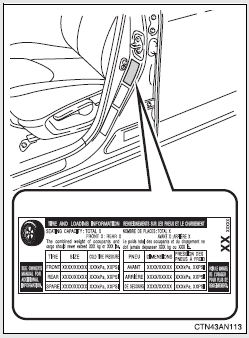
■ Inspection and adjustment procedure
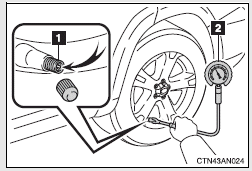
1 Tire valve
2 Tire pressure gauge
1 Remove the tire valve cap.
2 Press the tip of the tire pressure gauge onto the tire valve.
3 Read the pressure using the graduations of the gauge.
4 If the tire inflation pressure is not within the recommended
levels, adjust the pressure.
If you add too much air, press the center of the valve to
lower.
5 After completing the tire inflation pressure measurement
and adjustment, apply soapy water to the valve and check
for leakage.
6 Reinstall the tire valve cap.
■Tire inflation pressure check interval
You should check tire inflation pressure every two weeks, or at least once a month. Do not forget to check the spare.
■Effects of incorrect tire inflation pressure
Driving with incorrect tire inflation pressure may result in the following:
●Reduced fuel efficiency
●Reduced driving comfort and tire life
●Reduced safety
●Damage to the drive train
If a tire needs frequent refilling, have it checked by your Toyota dealer.
■Instructions for checking tire inflation pressure
When checking tire inflation pressure, observe the following:
●Check only when the tires are cold.
If your vehicle has been parked for at least 3 hours and has not been
driven for more than 1 mile or 1.5 km, you will get an accurate cold
tire inflation pressure reading.
●Always use a tire pressure gauge.
The appearance of the tire can be misleading. In addition, tire inflation
pressures that are even just a few pounds off can degrade ride
and handling.
●Do not bleed or reduce tire inflation pressure after driving. It is normal
for the tire inflation pressure to be higher after driving.
●Never exceed the vehicle capacity weight.
Passengers and luggage weight should be placed so that the vehicle is balanced.
CAUTION
■Proper inflation is critical to save tire performance
Keep your tires properly inflated.
Otherwise, the following conditions may occur and result in an accident
causing death or serious injury.
●Excessive wear
●Uneven wear
●Poor handling
●Possibility of blowouts resulting from overheated tires
●Poor sealing of the tire bead
●Wheel deformation and/or tire separation
●A greater possibility of tire damage from road hazards
NOTICE
■When inspecting and adjusting tire inflation pressure
Be sure to reinstall the tire valve caps.
Without the valve caps, dirt or moisture could get into the valve and
cause air leakage, which could result in an accident. If the caps have
been lost, replace them as soon as possible.
Wheels
If a wheel is bent, cracked or heavily corroded, it should be replaced. Otherwise, the tire may separate from the wheel or cause loss of handling control.
■ Wheel selection
When replacing wheels, care should be taken to ensure that they are equivalent to those removed in load capacity, diameter, rim width, and inset*. Replacement wheels are available at your Toyota dealer.
*: Conventionally referred to as “offset”.
Toyota does not recommend using:
● Wheels of different sizes or types
● Used wheels
● Bent wheels that have been straightened
■ Aluminum wheel precautions
● Use only Toyota wheel nuts and wrenches designed for use
with your aluminum wheels.
● When rotating, repairing or changing your tires, check that the
wheel nuts are still tight after driving 1000 miles (1600 km).
● Be careful not to damage the aluminum wheels when using
tire chains.
● Use only Toyota genuine balance weights or equivalent and a
plastic or rubber hammer when balancing your wheels.
■When replacing wheels (vehicles with a tire pressure warning system)
The wheels of your Toyota are equipped with tire pressure warning valves and transmitters that allow the tire pressure warning system to provide advanced warning in the event of a loss in tire inflation pressure. Whenever wheels are replaced, the tire pressure warning valves and transmitters must be installed.
CAUTION
■When replacing wheels
●Do not use wheels that are a different size from those recommended in
the Owner’s Manual, as this may result in loss of handling control.
●Never use an inner tube in a leaking wheel which is designed for a
tubeless tire. Doing so may result in an accident, causing serious
injury or death.
■When installing the wheel nuts

●Be sure to install the wheel nuts with
the tapered ends facing inward.
Installing the nuts with the tapered
ends facing outward can cause the
wheel to break and eventually cause
the wheel to come off while driving,
which could lead to an accident
resulting in death or serious injury.
●Never use oil or grease on the wheel bolts or wheel nuts.
Oil and grease may cause the wheel nuts to be excessively tightened,
leading to bolt or disc wheel damage. In addition, the oil or grease can
cause the wheel nuts to loosen and the wheel may fall off, causing an
accident and resulting in death or serious injury. Remove any oil or
grease from the wheel bolts or wheel nuts.
NOTICE
■Replacing tire pressure warning valves and transmitters (vehicles
with a tire pressure warning system)
●Because tire repair or replacement may affect the tire pressure
warning valves and transmitters, make sure to have tires serviced by
your Toyota dealer or other qualified service shop. In addition, make
sure to purchase your tire pressure warning valves and transmitters at
your Toyota dealer.
●Ensure that only genuine Toyota wheels are used on your vehicle.
Tire pressure warning valves and transmitters may not work properly
with non-genuine wheels.
Air conditioning filter
The air conditioning filter must be changed regularly to maintain air conditioning efficiency.
■ Removal method
1 Vehicles without smart key system: Turn the engine switch off.
Vehicles with smart key system: Turn the “ENGINE START STOP” switch off.
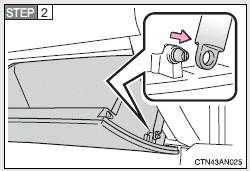
Open the glove box. Slide off the damper.
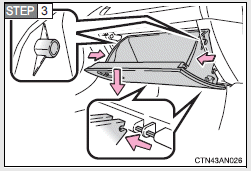
Push in each side of the glove box to disconnect the claws.
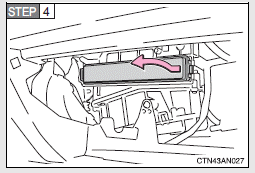
Remove the filter cover.
■ Replacement method
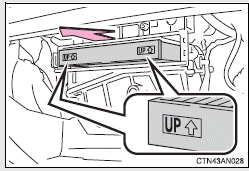
Remove the air conditioning filter and replace it with a new one. The “UP↑” marks shown on the filter should be pointing up.
■Checking interval
Inspect and replace the air conditioning filter according to the maintenance schedule. In dusty areas or areas with heavy traffic flow, early replacement may be required. (For scheduled maintenance information, please refer to the “Scheduled Maintenance Guide” or “Owner’s Manual Supplement”.)
■If air flow from the vents decreases dramatically
The filter may be clogged. Check the filter and replace it if necessary.
NOTICE
■When using the air conditioning system
Make sure that a filter is always installed.
Using the air conditioning system without a filter may cause damage to the
system.
Key battery
Replace the battery with a new one if it is discharged.
■ You will need the following items:
● Flathead screwdriver (To prevent damage to the key, cover
the tip of the screwdriver with a rag.)
● Small Flathead screwdriver
● Lithium battery CR2016 (vehicles without smart key system)
or CR1632 (vehicles with smart key system)
■ Replacing the battery (vehicles without smart key system)
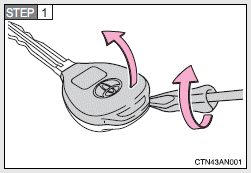
Remove the cover.
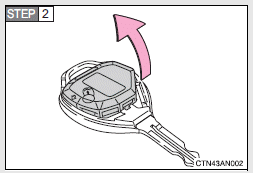
Remove the module.

Open the case cover using a coin protected with tape etc. and remove the depleted battery. Insert a new battery with the “+” terminal facing up.
■ Replacing the battery (vehicles with smart key system)
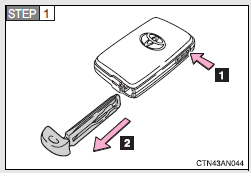
Take out the mechanical key.
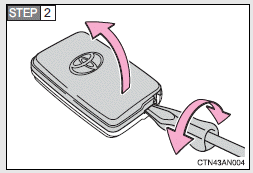
Remove the cover.
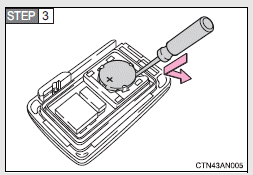
Remove the depleted battery. Insert a new battery with the “+” terminal facing up.
■If the key battery is depleted
The following symptoms may occur.
●The smart key system and wireless remote control will not function
properly.
●The operational range is reduced.
■Use a CR2016 (vehicles without smart key system) or CR1632 (vehicles with smart key system) lithium battery
●Batteries can be purchased at your Toyota dealer, jewelers, or camera
stores.
●Replace only with the same or equivalent type recommended by your
Toyota dealer.
●Dispose of used batteries according to the local laws.
CAUTION
■Removed battery and other parts
Keep away from children. These parts are small and if swallowed by a child,
they can cause choking. Failure to do so could result in death or serious
injury.
NOTICE
■For normal operation after replacing the battery
Observe the following precautions to prevent accidents.
●Always work with dry hands.
Moisture may cause the battery to rust.
●Do not touch or move any other components inside the remote control.
●Do not bend either of the battery terminals.
Checking and replacing fuses
If any of the electrical components do not operate, a fuse may have blown. If this happens, check and replace the fuses as necessary.
1 Vehicles without smart key system: Turn the engine switch off. Vehicles with smart key system: Turn the “ENGINE START STOP” switch off. 2 The fuses are located in the following places. To check the fuses, follow the instructions below. 3 Open the fuse box cover.
Engine compartment
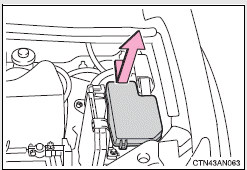
Type A: Push the tab in and lift the lid off.
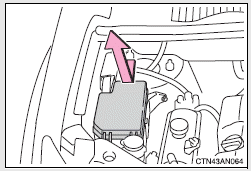
Type B: Push the tab in and lift the lid off.
Under the instrument panel
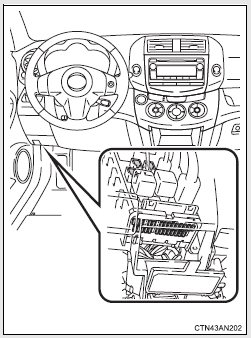
Remove the lid.
4 After a system failure, see “Fuse layout and amperage ratings” for details about which fuse to check.
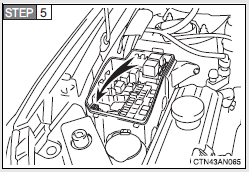
Remove the fuse with the pullout tool.
6 Check if the fuse has blown.
Type A

1 Normal fuse
2 Blown fuse
Replace it with one of an appropriate amperage rating. The amperage rating can be found on the fuse box lid.
Type B
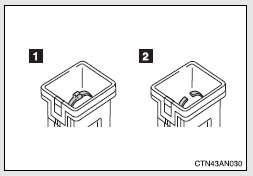
1 Normal fuse
2 Blown fuse
Replace it with one of an appropriate amperage rating. The amperage rating can be found on the fuse box lid.
Type C
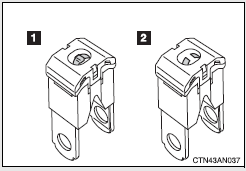
1 Normal fuse
2 Blown fuse
Contact your Toyota dealer.
Type D
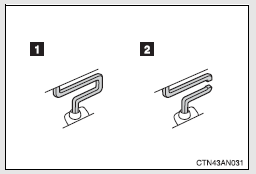
1 Normal fuse
2 Blown fuse
Contact your Toyota dealer.
Type E
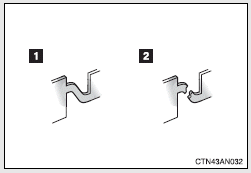
1 Normal fuse
2 Blown fuse
Contact your Toyota dealer.
Fuse layout and amperage ratings
■ Engine compartment
Type A (driver’s side)
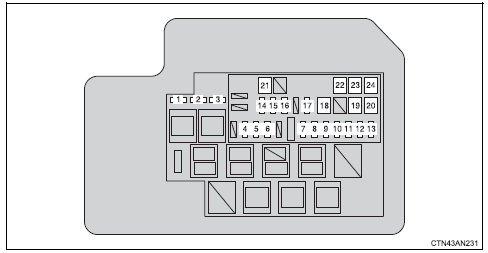

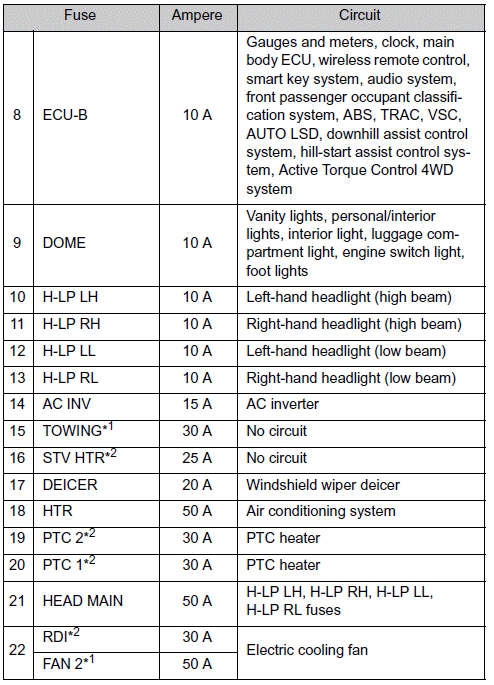

*1: Vehicles with towing package
*2: Vehicles with 2.5 L 4-cylinder (2AR-FE) engine
*3: Vehicles with 3.5 L V6 (2GR-FE) engine
Type B (passenger’s side)
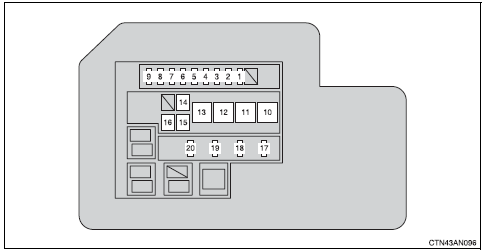
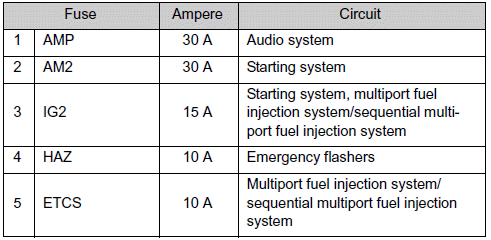
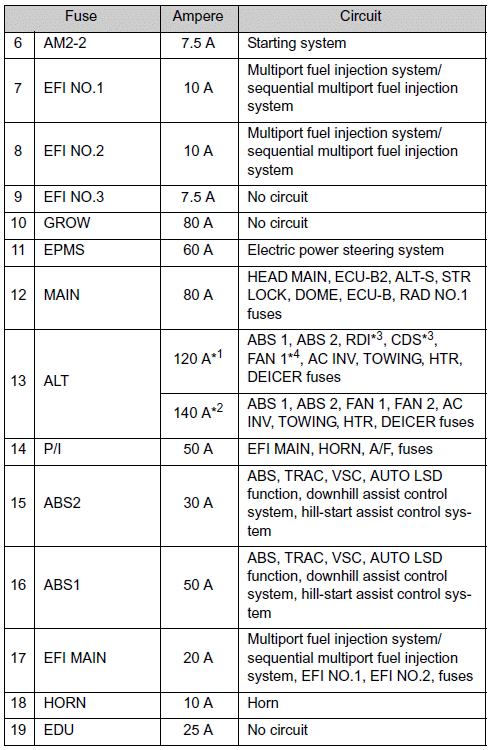

*1: Vehicles without towing package
*2: Vehicles with towing package
*3: Vehicles with 2.5 L 4-cylinder (2AR-FE) engine
*4: Vehicles with 3.5 L V6 (2GR-FE) engine
■ Under the instrument panel
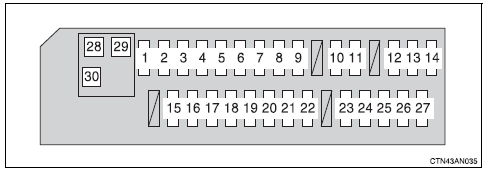
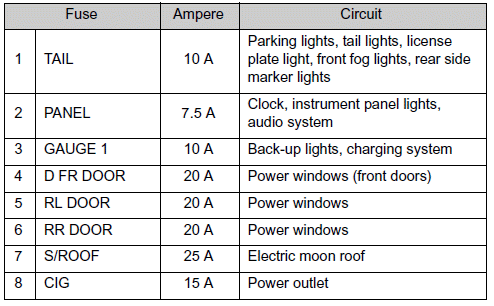

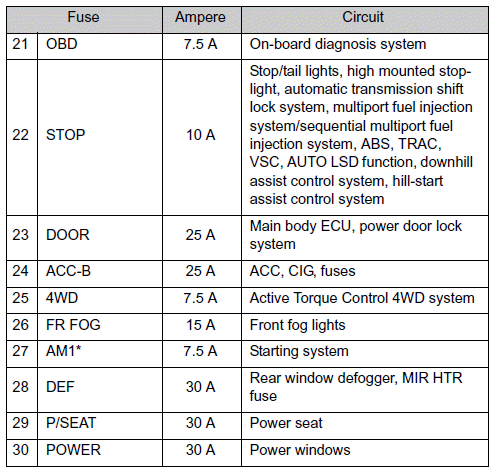
*: Vehicles without smart key system
■After a fuse is replaced
●If the lights do not turn on even after the fuse has been replaced, a bulb
may need replacement.
●If the replaced fuse blows again, have the vehicle inspected by your
Toyota dealer.
■If there is an overload in the circuits
The fuses are designed to blow, protecting the wiring harness from damage.
CAUTION
■To prevent system breakdowns and vehicle fire
Observe the following precautions.
Failing to do so may cause damage, and possibly a fire or injury.
●Never use a fuse of a higher amperage rating than indicated, or use any
other object in place of a fuse.
●Always use a genuine Toyota fuse or equivalent.
Never replace a fuse with a wire, even as a temporary fix.
This can cause extensive damage or even fire.
●Do not modify fuses or the fuse box.
NOTICE
■Before replacing fuses
Have the cause of electrical overload determined and repaired by your
Toyota dealer as soon as possible.
Light bulbs
You may replace the following bulbs yourself. The difficulty level of replacement varies depending on the bulb. If necessary bulb replacement seems difficult to perform, contact your Toyota dealer. For more information about replacing other light bulbs, contact your Toyota dealer.
■ Preparing a light bulb for replacement
Check the wattage of the light bulb being replaced.
■ Removing the engine compartment cover
■ Front bulb locations

■ Rear bulb locations
Vehicles without a spare tire
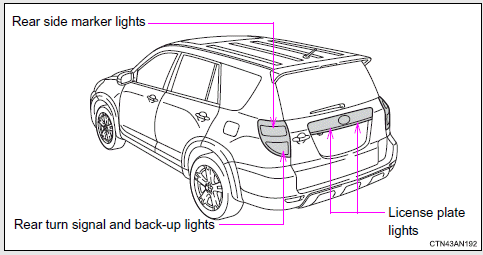
Vehicles with a spare tire
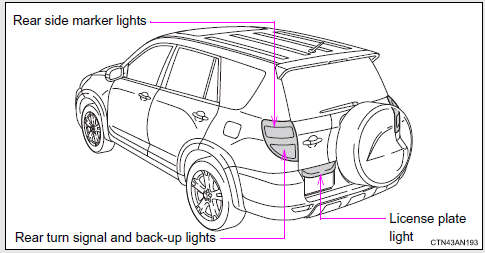
Replacing light bulbs
■ Headlights
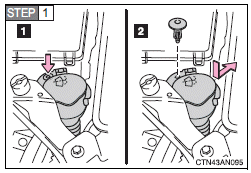
Right side only: Remove the clip and move it aside to allow easy access to the light bulbs.
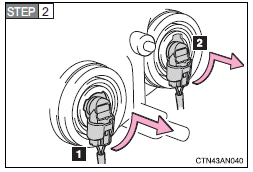
Turn the bulb base counterclockwise.
1 Headlight (low beam)
2 Headlight (high beam)

Unplug the connector while depressing the lock release.
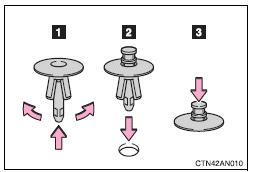
Reinstalling the clip
■ Front turn signal, parking and front side marker lights

Right side only: Remove the clip and move it aside to allow easy access to the light bulbs.
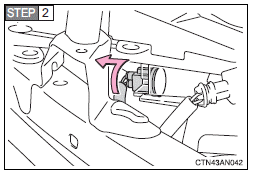
Turn the bulb base counterclockwise.

Remove the light bulb.
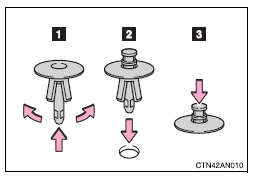
Reinstalling the clip
■ Front fog lights (if equipped)
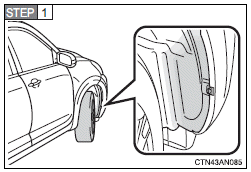
Turn the steering wheel in the opposite direction of the front fog light that you wish to replace. For example, if you wish to replace the front fog light on the right side, turn the steering wheel to the left.
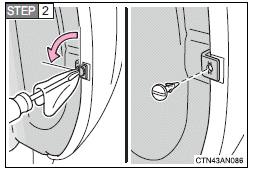
Remove the clip using a flathead screwdriver wrapped in a rag.
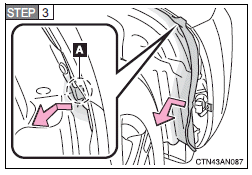
Move section “A” of the fender liner to the inner side of the vehicle, partly removing it and thereby allowing access to the front fog light.
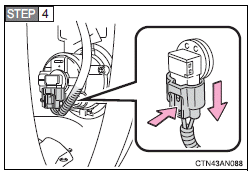
Unplug the connector while depressing the lock release.

Turn the bulb base counterclockwise.
■ Back-up lights, rear turn signal and rear side marker lights
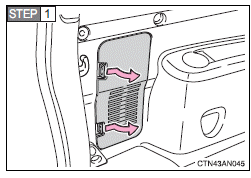
Open the back door and remove the cover.

Turn the bulb base counterclockwise.
1 Rear side marker light
2 Rear turn signal light
3 Back-up light
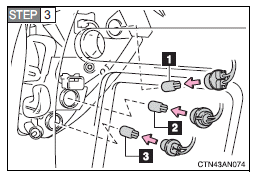
Remove the light bulb.
1 Rear side marker light
2 Rear turn signal light
3 Back-up light
■ License plate lights
Vehicles without a spare tire
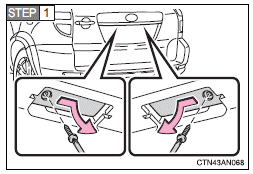
Remove the cover as shown in the illustration.
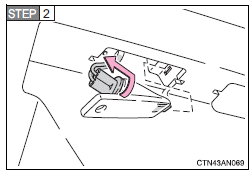
Turn the bulb base counterclockwise.
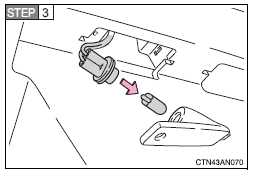
Remove the light bulb.
Vehicles with a spare tire
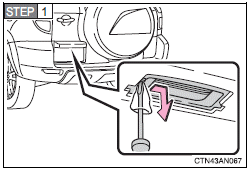
Use a flathead screwdriver to disengage the side of the lamp.
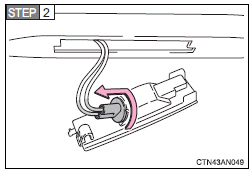
Turn the bulb base counterclockwise.
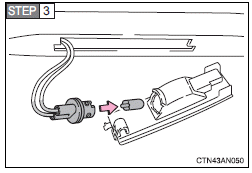
Remove the light bulb.
■ Light other than the above
If any of the lights listed below has burnt out, have it replaced by your Toyota dealer.
● High mounted stoplight
● Stop/tail lights
● Side turn signal lights (if equipped)
■Condensation build-up on the inside of the lens
Contact your Toyota dealer for more information in the following situations. Temporary condensation build-up on the inside of the headlight lens does not indicate a malfunction.
●Large drops of water are built up on the inside of the lens.
●Water has built up inside the headlight.
■LED side turn signal lights (if equipped), stop/tail lights and high mounted stoplight
The side turn signal lights, stop/tail lights and high mounted stoplight consists of a number of LEDs. If any of the LEDs burn out, take your vehicle to your Toyota dealer to have the light replaced.
CAUTION
■Replacing light bulbs
●Turn off the lights. Do not attempt to replace the bulb immediately after
turning off the lights.
The bulbs become very hot and may cause burns.
●Do not touch the glass portion of the light bulb with bare hands. Hold the
bulb by the plastic or metal portion.
If the bulb is scratched or dropped it may blow out or crack.
●Fully install light bulbs and any parts used to secure them. Failing to do so
may result in heat damage, fire, or water entering the headlight unit. This
may damage the headlights or cause condensation to build up on the lens.
■To prevent damage or fire
Make sure bulbs are fully seated and locked.
See also:
Corrosion protection
Protecting Your Hyundai from Corrosion
By using the most advanced design and construction
practices to combat corrosion,
Hyundai produces cars of the highest quality.
However, this is only part of the job. To achieve
the long-term corrosion ...
Manual transmission
The shift pattern is shown on the gearshift lever knob. Be sure to always fully
depress the clutch pedal before attempting to shift the lever.
CAUTION:
● Do not put the gearshift lever into the reverse position while the vehicle is
mov ...

 Maintenance
Maintenance